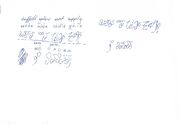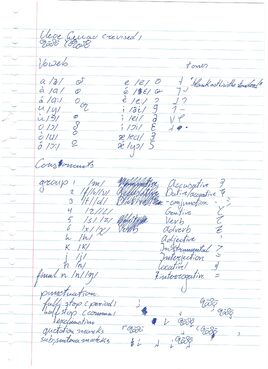| Progress 74% | ||||||||||||||||||||||||||||||||||||||||||||||||||||||||||||||||||||||||||||||||||||||||||||||||||||||
|
| ||||||||||||||||||||||||||||||||||||||||||||||||||||||||||||||||||||||||||||||||||||||||||||||||||||||
|
||||||||||||||||||||||||||||||||||||||||||||||||||||||||||||||||||||||||||||||||||||||||||||||||||||||
| Ueoe Ueoe | |||
|---|---|---|---|
| Type | |||
| Fusional | |||
| Alignment | |||
| Nominative-Accusative | |||
| Head direction | |||
| Initial | |||
| Tonal | |||
| Yes | |||
| Declensions | |||
| No | |||
| Conjugations | |||
| No | |||
| Genders | |||
| No | |||
| Nouns decline according to... | |||
| Case | Number | ||
| Definiteness | Gender | ||
| Verbs conjugate according to... | |||
| Voice | Mood | ||
| Person | Number | ||
| Tense | Aspect | ||
General information[]
Phonology[]
Consonants[]
| labial | Dental | Alveolar | Palatal | Velar | Uvular | Glottal | |
|---|---|---|---|---|---|---|---|
| Nasal | m | n | ŋ | ||||
| Plosive | t d | k | |||||
| Fricative | f v | s z | x | χ | h | ||
| Approximant | ʋ | j | |||||
| Trill | r | ||||||
| Lateral app. | l |
Vowels[]

example of the ueoe writing system in use.
| Front | Central | Back | |
|---|---|---|---|
| Close | i y (u) | u (ò) | |
| Close-mid | e (e) eː (é) | ɘ (ù) | o: (ó) |
| Open-mid | ɛ (è) | ɔ (o) ɔː (ó) | |
| Open | a (a) | ɑ (à) ɑː (á) |
diptongs : /ai/ (i), /ei/ (ì), /ɔi/ (í), /eɑ/ (æ), /yɔ/ (ǽ)
notes : U on the end of a word is pronaunced /i/
Tones[]
| tone | motionless + romanization | motion + romanization | ||
|---|---|---|---|---|
| high | ˥ (3) | (3) | ˧˥ (23) | (5) |
| mid | ˧ (2) | ˥˩ (31) | (4) | |
| low | ˩ (1) | (1) | ˩˧ (12) | (2) |

Ueoe writing system (1.1)
In romanization, the number is written in superscript above(after) the vowel that is tonal.
Alphabet[]
The consonants in Ueoe carry mostly a grammatical function, They are grooped per function. The differences between the consonants otherwise is only phoenetical, a speaker is free to chose from the group as long as the grammar stays allright.
Most of the groups carry some simularities in phonetics. Speakers who live close to each other mostly use the same consonants in the same cases.
Consonants within the word itself carry less of a function, they are free to chose, but do not change the meaning of the word.
Only the final n (ŋ) changes the function a bit, it gives the word a questional feeling.
Phonotactics[]
A syllable in Ueoe is formed as (C)V(n)
C are all the possible consonants (except ŋ).
V are all vowels + tones (if tone is empty, tone = mid-motionless)
n can be n at the end of a syllable, if the syllable is the last syllable of the word it forms ŋ.
Grammar[]
Ueoe Genders (classes)[]
| gender | subgender | vowel | example (ueoe > English) |
|---|---|---|---|
| Animate | Human | a | Aeo mouth |
| Animal | à | Àeo beak | |
| Human (2) | á | Áeo loud (speaking a lot) | |
| (inter) action | Human cause | u | Ueoe speech |
| Natural cause | ù | Ùeoe breeze | |
| Object | Natural (small | o | Oaa stone |
| Artificial | ò | Òaa pile | |
| Natural (big) | ó | Óaa mountain | |
| Abstract | Unreachable | e | Eaoa sky |
| Unknown | è | Èaoa heaven | |
| Theoretical | é | Éaoa air |
Ueoe initial consonants.[]
| group | ipa | function |
|---|---|---|
| group 0 | >none< | Nominative |
| group 1 | /m/ | Accusative |
| group 2 | /f//v//ʋ/ | Dative |
| group 3 | /t//d/ | Conjunction |
| group 4 | /r//l/ | Genitive |
| group 5 | /s//z/ | Verb |
| group 6 | /x//χ/ | Adverb |
| h | /h/ | Adjective |
| k | /k/ | instumental |
| j | /j/ | Interjection |
| n | /n/ | Locative |
| final n | /n//ŋ/ | Interrogative |
2nd consonant[]
verb tenses[]
| tense | 2nd vowel | ipa |
|---|---|---|
| gnomic | group 0 | >none< |
| past | group 3 | /t//d/ |
| future | group 6 | /x//χ/ |
| far-past | group 2 | /f//v//ʋ/ |
| present | group 5 | /s//z/ |
comparisons (for adjectives)[]
| compare | English | 2nd vowel | ipa |
|---|---|---|---|
| standard | >none< | group 0 | >none< |
| comparative | more | group 3 | /t//d/ʋ/ |
| superlative | most | group 5 | /s//z/ |
| anti-comperative | less | group 2 | /f//v// |
| anti-superlative | least | group 6 | /x//χ/ |
| anti | not | k | /k/ |
One-vowel words.[]
| word kind | word | Ueoe | ipa |
|---|---|---|---|
| Personal Pronouns | I / we | à | /ɑ/ |
| you | i | /ai/ | |
| he she it they | æ | /eɑ/ | |
| Demonstratives | here | ò | /u/ |
| there (close by) | í | /ɔi/ | |
| there (further away) | u | /i/ | |
| there (not visible/ far wasy) | ó | /ɔː/ | |
| opening for loanwords (not word native for Ueoe) | e | /e/ | |
| Opening for names that are not Ueoe | ì | /ei/ | |
| opening for names Ueoe (higher rank) | á | /ɑː/ | |
| opening for names Ueoe (lowwer rank) | é | /eː/ | |
| opening for names Ueoe (equal rank) | è | /ɛ/ | |
Vocabulary[]
for all the vocab go here
Example text[]
For the examples, go here .
